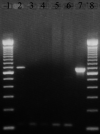Prevalence of Coxiella burnetii DNA in vaginal and uterine samples from healthy cats of north-central Colorado
- PMID: 17208030
- PMCID: PMC10822629
- DOI: 10.1016/j.jfms.2006.11.006
Prevalence of Coxiella burnetii DNA in vaginal and uterine samples from healthy cats of north-central Colorado
Abstract
Q fever is a worldwide zoonotic disease caused by Coxiella burnetii. Although traditionally associated with livestock exposure, human infection has also been documented from contact with parturient cats. The goal of this study was to determine the prevalence of C burnetii DNA in uterine and vaginal tissues from healthy client-owned and shelter cats of north-central Colorado using polymerase chain reaction assay. Coxiella burnetii was not amplified from vaginal samples of any cat or uterine biopsies of shelter cats. However, a nucleotide sequence with 99% homology to C burnetii DNA was amplified from four of 47 (8.5%) uterine biopsies of client-owned cats. This study demonstrates that clinically normal cats in north-central Colorado can harbor C burnetii. Care should be taken when attending to parturient cats and contact with parturient secretions should be avoided. Additional studies are indicated to further characterize the role of cats in zoonotic Q fever.
Figures

Similar articles
-
Evaluation of associations among Coxiella burnetii and reproductive abnormalities in cats.J Feline Med Surg. 2016 Apr;18(4):344-7. doi: 10.1177/1098612X15584693. Epub 2015 May 5. J Feline Med Surg. 2016. PMID: 25944579 Free PMC article.
-
Molecular detection of Coxiella burnetii in raw meat intended for pet consumption.Zoonoses Public Health. 2020 Jun;67(4):443-452. doi: 10.1111/zph.12707. Epub 2020 Apr 29. Zoonoses Public Health. 2020. PMID: 32347659
-
New insights on the epidemiology of Coxiella burnetii in pet dogs and cats from New South Wales, Australia.Acta Trop. 2020 May;205:105416. doi: 10.1016/j.actatropica.2020.105416. Epub 2020 Feb 24. Acta Trop. 2020. PMID: 32105667
-
Q fever in Japan: an update review.Vet Microbiol. 2011 May 5;149(3-4):298-306. doi: 10.1016/j.vetmic.2010.11.017. Epub 2010 Nov 19. Vet Microbiol. 2011. PMID: 21146331 Review.
-
Molecular prevalence of Coxiella burnetii in milk in Iran: a systematic review and meta-analysis.Trop Anim Health Prod. 2019 Jul;51(6):1345-1355. doi: 10.1007/s11250-019-01807-3. Epub 2019 Feb 11. Trop Anim Health Prod. 2019. PMID: 30746592
Cited by
-
Arthropod-Borne Pathogens in Stray Cats from Northern Italy: A Serological and Molecular Survey.Animals (Basel). 2020 Dec 8;10(12):2334. doi: 10.3390/ani10122334. Animals (Basel). 2020. PMID: 33302522 Free PMC article.
-
Coxiella burnetii in Dogs and Cats from Portugal: Serological and Molecular Analysis.Pathogens. 2022 Dec 13;11(12):1525. doi: 10.3390/pathogens11121525. Pathogens. 2022. PMID: 36558859 Free PMC article.
-
Coxiella burnetii associated reproductive disorders in domestic animals--a critical review.Acta Vet Scand. 2013 Feb 18;55(1):13. doi: 10.1186/1751-0147-55-13. Acta Vet Scand. 2013. PMID: 23419216 Free PMC article. Review.
-
Coxiellosis/Q fever in cats: ABCD guidelines on prevention and management.J Feline Med Surg. 2013 Jul;15(7):573-5. doi: 10.1177/1098612X13489216. J Feline Med Surg. 2013. PMID: 23813818 Free PMC article. Review.
-
Role of vector-borne pathogens in the development of fever in cats: 1. Flea-associated diseases.J Feline Med Surg. 2020 Jan;22(1):31-39. doi: 10.1177/1098612X19895941. J Feline Med Surg. 2020. PMID: 31916873 Free PMC article. Review.
References
-
- Arashima Y., Kato K., Komiya T., Kumasaka K., Matsukawa Y., Murakami M., Takahashi K., Ikeda T., Arakawa Y. Improvement of chronic nonspecific symptoms by long-term minocycline treatment in Japanese patients with Coxiella burnetii infection considered to have post-Q fever fatigue syndrome, Internal Medicine 43, 2004, 49–54. - PubMed
-
- Ayres J.G., Flint N., Smith E.G., Tunnicliffe W.S., Fletcher T.J., Hammond K., Ward D., Marmion B.P. Post-infection fatigue syndrome following Q fever, Quarterly Journal of Medicine 91, 1998, 105–123. - PubMed
-
- Babudieri B. Q fever: a zoonosis, Advances in Veterinary Science 5, 1959, 81.
-
- Berri M., Laroucau K., Rodolakis A. The detection of Coxiella burnetii from ovine genital swabs, milk and fecal samples by the use of a single touchdown polymerase chain reaction, Veterinary Microbiology 72, 2000, 285–293. - PubMed
MeSH terms
Substances
LinkOut - more resources
Full Text Sources
Miscellaneous

